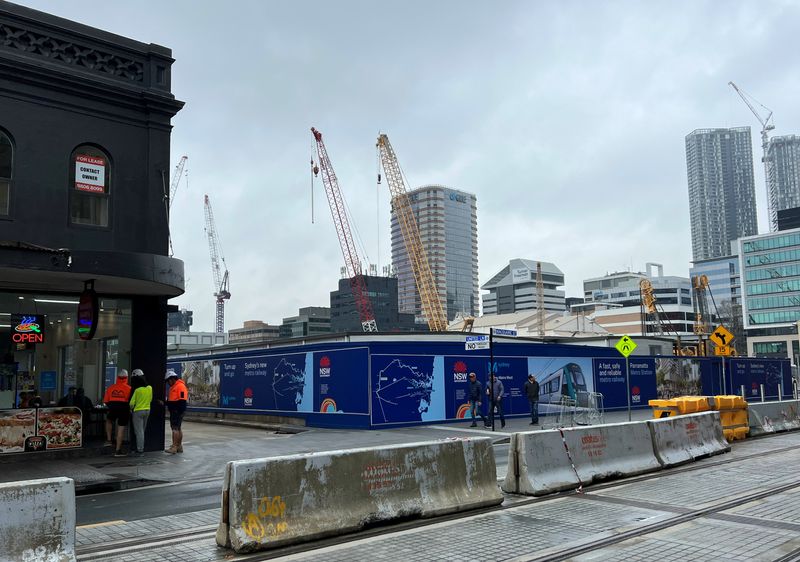By Stella Qiu
SYDNEY (Reuters) -Australia's economy grew at a snail's pace in the December quarter as a punishing squeeze on household incomes brought consumer spending to a standstill, reinforcing market bets that the next move in interest rates will be down.
The slowdown confirmed high borrowing costs were working all too well to curb demand, prompting treasurer Jim Chalmers to declare that the balance of risks in the economy is shifting from inflation to growth.
Data from the Australian Bureau of Statistics on Wednesday showed real gross domestic product (GDP) rose 0.2% in the fourth quarter, under forecasts of 0.3%. That compared with a upwardly revised 0.3% expansion in the prior quarter.
Annual growth slowed to 1.5%, down from 2.1% the previous quarter and the lowest since early 2021, when the economy was emerging from a pandemic-driven recession.
In a telling sign of the softness in domestic demand, household spending did not add to economic growth at all in the fourth quarter, as a 0.7% rise in spending on essentials was offset by a 0.9% fall in discretionary spending.
ABS data showed households are spending more on electricity, rent, food and health while cutting back on hotels, cafes and restaurants as well as things like new vehicle purchases and clothing and footwear.
"Australian consumers are suffering from higher interest rates and cost of living pressures, while the rate of housing investment remains in the doldrums," said Deloitte Access Economics partner Stephen Smith.
"There is simply not enough demand in the Australian economy to justify the RBA's claim about 'homegrown' inflation... Monetary and fiscal policy need to pivot away from containing inflation to stimulating economic growth."
'NEED TO RESPOND'
The RBA has raised interest rates by a whopping 425 basis points since May 2022 to tame inflation, and has not ruled out another rise due to persistently high services price pressures, even as headline inflation has retreated to two-year lows.
The central bank had expected the economy to slow to an annual 1.5% by the end of the last year and to 1.3% by mid 2024.
Australia is not alone in facing pressure on growth. Globally, economic growth has slowed in response to elevated interest rates, fanning rate cut expectations later in the year. Both Japan and Britain slipped into a recession in the second half of last year, while the euro zone economy has also stalled.
Growth in Australia has been supported by record immigration, but on a per capita basis, GDP fell 0.3% for the December quarter, shrinking for three straight quarters in the longest declining streak since 1982.
While the household saving ratio did rebound to 3.2%, it was still subdued after sitting at 1.9% in the previous quarter.
Net trade was a big driver of growth, with a pull-back in imports - thanks to Australians spending less money overseas - adding 0.7 percentage points to fourth-quarter GDP growth.
"Addressing inflation is still our primary concern, but these numbers show that the balance of risks in our economy are shifting from inflation to growth," said Treasurer Jim Chalmers at a briefing.
"If you look at these quarterly figures, if you look at the way inflation is coming off in welcome and encouraging ways, we need to respond to that," said Chalmers, who is expected to unveil the government's budget in May.

Analysts expect the economy will continue to slow down in the months ahead before picking up in the second half of the year. Markets are pricing the first rate cut from the RBA to come in August.
"That means 2024 will be a tale of two halves. The first defined by lingering cost-of-living pressures and the second half by relief in the form of tax and rate cuts," said Harry Murphy Cruise, Economist, Moody’s Analytics.